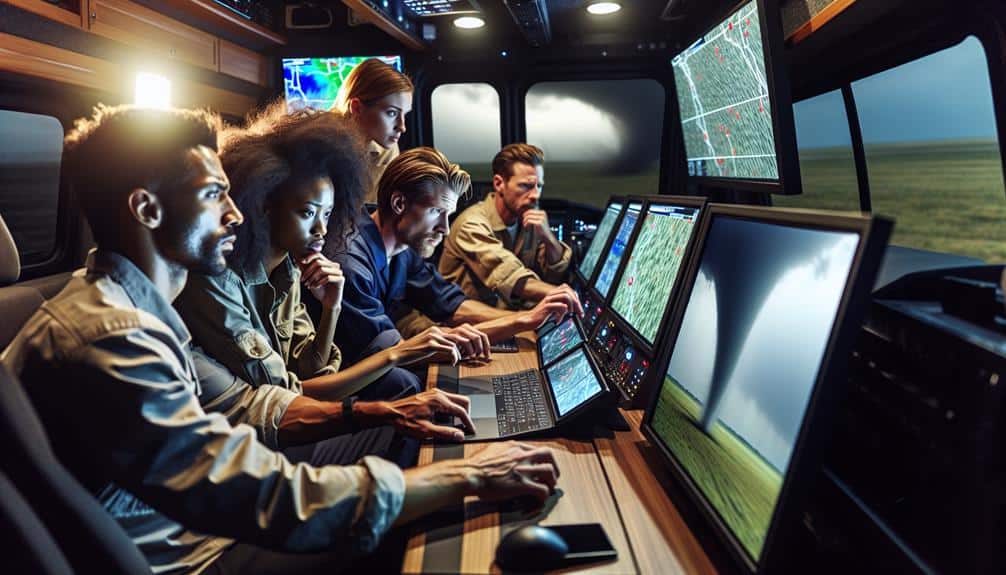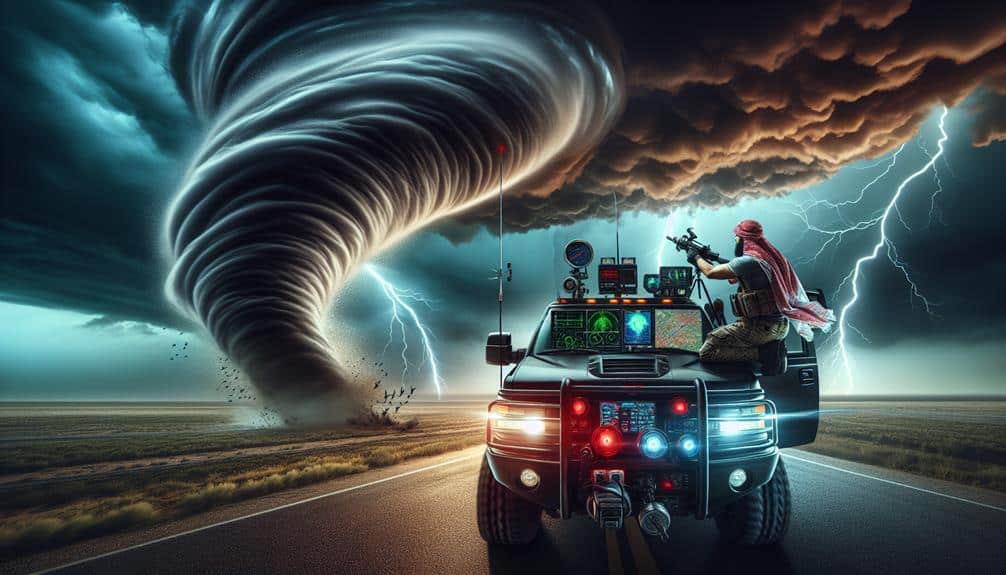We systematically integrate team feedback into our storm chasing risk assessments to enhance accuracy and real-time decision making. By leveraging diverse expertise and real-time communication tools, we gather critical meteorological indicators and adjust our strategies dynamically. Debriefing sessions allow for continuous improvement by reflecting on past events. Cross-disciplinary insights enhance storm prediction models, ensuring precise adjustments under high-pressure conditions. Sharing accountability and fostering transparency among team members minimizes errors and maximizes data accuracy. With strong team cohesion, we achieve effective responses to weather threats. Continue to learn about our methods and see how they improve prediction accuracy and safety.
Key Points
- Team feedback integrates diverse expertise, enhancing the accuracy of risk assessments.
- Real-time team communication facilitates quick data gathering and distribution.
- Post-event debriefing sessions contribute to the continuous improvement of safety protocols.
- Diverse perspectives help identify patterns and anomalies for more accurate storm predictions.
Importance of Team Feedback
Recognizing the significant role of team feedback, we make certain that every member's input is systematically integrated into our storm chasing risk evaluation protocols. Our dedication to team collaboration guarantees that each piece of data, experience, and insight is analyzed meticulously. By leveraging diverse expertise, we enhance our risk evaluation's accuracy, allowing us to make well-informed decisions that maximize safety and efficiency.
We use real-time communication tools to gather and distribute information quickly. This method not only speeds up the process but also ensures that no valuable input is overlooked. Our team members are trained to identify and report various meteorological indicators, from wind shear to atmospheric instability, which are essential for evaluating potential storm hazards. By incorporating these detailed observations, we refine our risk models and improve prediction accuracy.
Moreover, our feedback loop is designed to be iterative. After each storm chasing event, we conduct a debriefing session where team members can discuss their observations and experiences. This continuous improvement cycle helps us update our protocols, ensuring they remain relevant and effective.
Essentially, our approach to risk evaluation is dynamic, data-driven, and deeply rooted in collective expertise, providing us the freedom to chase storms safely and efficiently.
Gathering Diverse Perspectives
When we gather diverse perspectives, we leverage varied expertise contributing to a more thorough risk assessment.
This collective input enhances our decision-making processes by incorporating multiple viewpoints and specializations.
Consequently, we achieve a thorough risk analysis that better prepares us for the complexities of storm chasing.
Varied Expertise Contribution
Incorporating insights from meteorologists, engineers, and emergency responders enhances the strength of our storm chasing risk assessments by leveraging their diverse expertise.
This multidisciplinary approach allows for a thorough expertise exchange, ensuring that all potential hazards are addressed.
Meteorologists provide precise weather predictions and storm behavior patterns, which are essential for anticipating risk areas.
Engineers contribute by evaluating the structural integrity of our equipment and vehicles, ensuring that we can withstand extreme conditions without compromising safety.
Emergency responders offer important strategies for rapid response and resource allocation, which are crucial during high-risk situations.
Enhanced Decision Making
Our team's ability to gather diverse perspectives enhances our decision-making process by integrating the specialized knowledge of various experts into a cohesive risk assessment strategy. Consequently, we achieve improved communication and increased responsibility, both vital in the high-stakes environment of storm chasing.
By actively soliciting input from meteorologists, engineers, and field operatives, we ensure that our risk assessments are grounded in detailed, multifaceted data. This collaborative approach allows us to incorporate real-time observations, predictive models, and technical insights, creating a richer, more accurate understanding of potential risks.
Improved communication is facilitated through regular briefings and debriefings, where all team members share their findings and interpretations. This open exchange of information not only enhances situational awareness but also allows for quick adjustments in strategy, guaranteeing we remain agile and responsive to dynamic weather conditions.
Increased responsibility comes from our commitment to transparency and shared accountability. Each expert's contribution is documented and reviewed, fostering a culture of thorough validation and mutual trust. This meticulous vetting process minimizes errors and elevates the overall quality of our risk assessments, empowering us to make informed, confident decisions in the face of uncertainty.
Comprehensive Risk Analysis
We leverage multi-disciplinary expertise to conduct a detailed risk analysis, ensuring that each perspective contributes to a thorough and accurate assessment of storm-related hazards. By integrating diverse viewpoints, we enhance our ability to identify potential risks and implement effective risk mitigation strategies. Our team dynamics play an essential role in this process, fostering a collaborative environment where each member's insights are valued.
To achieve a comprehensive risk analysis, we focus on the following key areas:
- Meteorological Data Analysis: We combine data from meteorologists, radar specialists, and climate scientists to predict storm behavior accurately. This multi-faceted approach helps us identify patterns and potential threats more effectively.
- Technological Integration: We utilize advanced technologies such as drones, mobile radar units, and real-time data analytics. These tools provide us with precise, up-to-the-minute information that's crucial for making informed decisions during storm chasing operations.
- Human Factors Assessment: We assess the psychological and physical readiness of our team members. Understanding how stress and fatigue can impact decision-making allows us to implement measures that enhance team performance and safety.
Real-Time Decision Making

Accurate real-time decision making in storm chasing hinges on assimilating diverse data inputs and leveraging team feedback to navigate rapidly evolving weather conditions. We rely on immediate responses from our team, who are constantly monitoring radar data, satellite images, and visual observations. These inputs allow us to make quick adjustments to our chase strategy, enhancing our ability to stay safe while capturing valuable data.
Our team's ability to communicate effectively in these high-pressure situations is essential. Real-time feedback guarantees that everyone is on the same page, enabling us to adapt to sudden changes in storm intensity or direction. For example, if the radar indicates a sudden shift in a storm cell, our navigators can immediately relay this information to the drivers, who can then adjust their route to maintain a safe distance.
Moreover, integrating feedback from different team members allows us to cross-verify data, reducing the risk of errors. This collaborative approach means we're not solely dependent on one source of information, increasing our overall situational awareness.
In storm chasing, where conditions can change in an instant, our ability to make informed, real-time decisions is what keeps us both effective and safe.
Enhancing Safety Protocols
To frequently enhance safety protocols in storm chasing, we must thoroughly analyze past incidents and incorporate lessons learned into our procedures. By doing so, we can implement targeted safety improvements and achieve effective risk mitigation.
The integration of team feedback is pivotal for refining our protocols and guaranteeing that everyone is prepared for emergency response scenarios.
Here's how we can enhance safety protocols:
- Incident Review and Analysis: We should conduct detailed post-storm debriefings where we analyze what worked and what didn't. This data-driven approach helps identify gaps and areas for improvement.
- Enhanced Team Communication: Effective communication is key during storm chases. Utilizing advanced communication tools and regular check-ins can help teams stay coordinated and informed, reducing the likelihood of missteps.
- Emergency Response Training: We must regularly update and practice our emergency response plans. This includes drills that simulate real-life scenarios to secure that everyone knows their roles and actions during a crisis.
Improving Prediction Accuracy

By leveraging team feedback, we can enhance data quality through collaborative efforts.
Diverse perspectives in analysis allow us to identify patterns and anomalies that single viewpoints might miss, leading to more accurate predictions.
Additionally, real-time adjustments based on collective input enable us to respond swiftly to evolving storm conditions.
Collaboration Enhances Data Quality
When storm chasers work together effectively, the resulting data quality greatly improves the accuracy of severe weather predictions. By combining our observations, skills, and expertise, we can achieve a level of data precision that's crucial for making exact forecasts. Team collaboration allows us to cross-verify data points, ensuring uniformity and reliability. For example, when multiple team members validate the same atmospheric readings, we can be more assured in our predictions.
In our experience, effective team collaboration hinges on several critical factors:
- Real-time Communication: Utilizing advanced communication tools enables us to share immediate observations and coordinate our movements, reducing the chance of duplicated or overlooked data.
- Data Integration: Combining data from various sources, such as Doppler radar, satellite imagery, and on-site instruments, provides a thorough view of storm dynamics, enhancing predictive models.
- Standardized Protocols: Adhering to standardized data collection and reporting protocols ensures uniformity and accuracy, making it simpler to compare data from different team members and locations.
Diverse Perspectives in Analysis
Diverse perspectives in analysis allow us to integrate varied expertise, thereby refining our storm prediction models with greater accuracy.
When we draw on cross-disciplinary insights, we leverage the strengths of meteorologists, data scientists, and engineers. Each member contributes unique viewpoints that enhance our collective understanding. For example, meteorologists provide critical insights into atmospheric dynamics, while data scientists optimize predictive algorithms using advanced statistical methods.
By synthesizing these diverse perspectives, we can identify patterns and anomalies that might otherwise go unnoticed. This collaborative approach ensures our predictive models are robust, and our risk assessments are thorough.
We've noticed that incorporating hydrology and climatology perspectives further sharpens our focus, allowing us to contemplate factors like soil moisture and long-term climate trends. These elements are vital for anticipating storm development and potential impacts.
Moreover, the inclusion of unique viewpoints encourages innovative problem-solving. When we integrate knowledge from various disciplines, we challenge conventional thinking and open new avenues for discovery. This not only improves prediction accuracy but also empowers us to make informed, data-driven decisions.
Ultimately, it's this diversity of thought that grants us the freedom to push the boundaries of storm chasing and risk assessment.
Real-Time Adjustments
Building on our diverse perspectives, we continuously refine our storm prediction models with real-time adjustments to enhance their accuracy. This ongoing process relies on constant communication among team members, enabling quick adjustments when new data emerges. By integrating real-time feedback, we guarantee our predictive models stay dynamic, providing us with the ability to make immediate changes as storm conditions evolve.
Our approach incorporates:
- Constant Communication: We maintain an open line of dialogue among meteorologists, data analysts, and field operatives. This allows us to rapidly share observations and update models, leading to quick adjustments that improve prediction fidelity.
- Dynamic Responses: As we monitor storm data, we apply dynamic responses to our models. These immediate changes are based on the latest radar readings, satellite imagery, and ground reports, ensuring our predictions align closely with the unfolding storm scenario.
- Data-Driven Precision: Leveraging machine learning algorithms and high-resolution datasets, we continuously calibrate our models. This data-driven approach ensures that each adjustment is backed by empirical evidence, enhancing our overall predictive accuracy.
Building Team Cohesion
Effective team cohesion directly enhances storm chasers' ability to accurately assess and respond to dynamic weather threats. By fostering strong team dynamics, we guarantee that each member understands their role and can seamlessly integrate their actions with others. This alignment minimizes response time and maximizes our ability to gather and interpret critical meteorological data.
Communication strategies are pivotal in maintaining this cohesion. We utilize both verbal and non-verbal cues to relay information swiftly and effectively, ensuring that no detail is lost in the chaos of the chase. Real-time feedback loops enable us to adjust our tactics on the fly, adapting to rapidly changing conditions without missing a beat.
Building team cohesion also involves regular training exercises where we simulate storm scenarios. These drills allow us to refine our team dynamics and communication strategies under controlled conditions, guaranteeing we're prepared for real-world situations. Data from these exercises highlight areas for improvement and reinforce successful practices, creating a continuous improvement cycle.
In essence, our ability to act as a cohesive unit not only enhances our safety but also increases the accuracy of our risk assessments. This unified approach empowers us to face the unpredictability of storm chasing with confidence and precision.
Frequently Asked Questions
How Does Team Feedback Impact Individual Storm Chaser Performance?
Team feedback acts as a well-oiled machine, enhancing our overall performance improvement. Effective communication skills and teamwork dynamics sharpen our decision-making strategies, ensuring each storm chaser's actions are precise and data-driven, maximizing individual and collective success.
What Technology Aids in Collecting Team Feedback During Storm Chases?
We use advanced communication tools like real-time chat apps and GPS trackers for data collection. These technologies guarantee seamless team feedback during storm chases, enhancing our decision-making and safety through precise, instantaneous information exchange.
How Is Feedback Integrated Into Post-Chase Evaluations?
We integrate feedback into post-chase evaluations by conducting risk analysis sessions. This collaboration helps us identify improvement areas and enhances overall effectiveness. Data-driven insights from team feedback are crucial for refining strategies and optimizing future storm-chasing operations.
Are There Any Psychological Effects of Team Feedback on Storm Chasers?
When we receive team feedback, it bolsters our mental resilience and emotional support, strengthening group cohesion. The positive impact on team dynamics can't be overstated, enhancing our psychological well-being and performance during high-stress storm-chasing scenarios.
How Does Team Feedback Influence Long-Term Storm Chasing Strategies?
Team feedback enhances our decision making dynamics and influences long-term storm chasing strategies by refining risk evaluation and promoting strategy adjustments. This fosters team cohesion, ensuring we adapt effectively and maintain the freedom to chase safely and efficiently.


